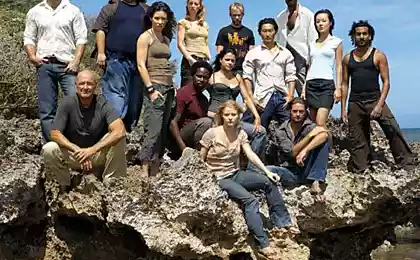764
15 cool facts about the time, which is not a pity to waste time
Time is running, time is not enough time ... Time heals everything is always present in our lives, but we rarely think about it - there is no time! The site invites you to learn more about the time - from our new collection of fascinating facts. Faster nowhere h2> The shortest amount of time with physical sense - the so-called Planck time. This is the time in which the photon is moving at the speed of light, will overcome the Planck length. The Planck length is expressed, in turn, through the formula, which linked the fundamental physical constants - the speed of light, the gravitational constant and the Planck constant. In quantum physics, it is believed that at distances smaller than the Planck length can not be applied understanding of the space-time continuum. The length of the Planck time is 5, 16 391 (13) · 10-44 with.
Merchants Greenwich h2> John Henry of Belleville, a member of the famous Greenwich Observatory in London, is still thought of in 1836, the time to sell. The essence of business is that Mr. Belleville daily check their watches with the exact hours of the observatory, and then traveled on to customers and allow them for the money to put an exact time on his watch. Service was so popular that was inherited by the daughter of John - Route Belleville that provide services before 1940, ie 14 years later, after the radio BBC BBC broadcasts the first time.
Without firing h2> Current timekeeping systems run on sprint a long way from the days when the judge fired a gun, and a stopwatch is started manually. As a result, now accounted for a split second, which is much shorter than the human response to all taxis electronics. Gun - a longer gun, stun device without pyrotechnics, transmitting exact start time on the computer. For because of the speed of sound propagation one runner did not hear the start signal before the other, "shot" is broadcast on speakers, set next to the runners. A false start as determined electronically, by means of sensors built into the starting blocks each runner. The finish time is recorded by the laser beam and photocell, as well as using ultra-fast camera that hits virtually every moment.
Second billions h2> The most accurate in the world is an atomic clock of JILA (Joint Institute for Laboratory Astrophysics) - Research Centre, based at the University of Colorado, Boulder. The center - a joint project of the University and the National Institute of Standards and Technology. In hours cooled to very low temperatures of strontium atoms are placed in a so-called optical traps. The laser causes the atoms to oscillate at a rate of 430 trillion oscillations per second. As a result, 5 billion years, the unit has accumulated error is only 1 second.
Atomic strength h2> Everyone knows that the most accurate clocks - the atomic. The GPS uses atomic clocks time. And if you watch to adjust the signal GPS, they will supertochnymi. This possibility already exists. Watch Astron GPS Solar Dual-Time, manufactured by Seiko, are on board chipset GPS, which gives them the ability to check a satellite signal and display only the exact time anywhere in the world. And no special power sources for this is not required: Astron GPS Solar Dual-Time is powered only by the energy of light through the panel built into the dial.
Do not anger the Jupiter h2> It is known that the majority of hours, where on the dial with Roman numerals, the fourth hour is represented by IIII instead of IV. Apparently, for this "substitution" is a long tradition, for a precise answer to the question who and why invented four incorrect, does not exist. But there are various legends, such as that as Roman numerals - are the same letters, the number of IV to provide first syllable of the name is very revered god Jupiter (IVPPITER). The appearance of the syllables on the dial of a sundial Romans allegedly considered sacrilege. From there, everything went. Those who do not believe the legends, it is believed that the case design. With the replacement of a IV in IIII. the first third of the dial is used only figure I, the second only I and V, and only the third I and X. Since the dial looks neat and orderly.
Day when dinosaurs h2> Someone in a day is not enough 24 hours, while the dinosaurs and that was not there. In ancient geological times the Earth rotated much faster. It is believed that during the formation of the Moon on the Earth day lasted two or three hours, and the moon, which was much closer Flied our planet for five hours. But gradually the lunar gravity slows the rotation of the Earth (by creating tidal waves that are produced not only in water but also in the crust and mantle), the orbital angular momentum of the Moon increased, satellite accelerated, shifted into a higher orbit, where its speed fell. This process continues to this day and age for a day increased by 1/500 sec. 100 million years ago, at the height of the era of the dinosaurs, the duration of the day was about 23 hours.
The abyss of time h2> Calendars in different ancient civilizations developed, not only for practical purposes, but also in close contact with religious and mythological views. Because of this, in the past calendar systems featured unit of time, much longer than the life of man, and even the existence of a period within these civilizations. For example, in the Mayan calendar featured such units of time as a "baktun" which amounted to 409 years, and the era of the 13 baktun (5125 years). Then all went to the ancient Indians - in their sacred texts featured universal activity during Maha Manvantara, is 311, 04 trillion years. For comparison, the period of the universe according to modern science - about 13, 8 billion years.
All of its midnight h2> Unified calculating time of the time zone appeared in the industrial era, and in the same world, especially in the agricultural part of it, by the time was organized in its own way in each locality, building on observed astronomical phenomena. Traces of the Archaic this can be seen today on Mount Athos in the Greek monastic republic. Here, too, used the clock, but midnight is the moment of sunset, and hours every day are exposed on this point. Given the fact that some monasteries are located higher in the mountains, and the other below, and for them the sun disappears behind the horizon at different times, even at midnight for them does not occur simultaneously.
Live longer - live deeper h2> The force of gravity slows the passage of time. In a deep mine, where the force of Earth's gravity is stronger, the time is slower than on the surface. And on top of Mount Everest - faster. The effect of the gravitational deceleration was predicted by Albert Einstein in 1907 in the framework of general relativity. Wait for confirmation of the effect of the pilot had more than half a century, until the equipment that can capture ultra small changes over time. Nowadays, the most accurate atomic clock fix the gravitational effect of slowing down when you change the height of a few tens of centimeters.
Time - stop! h2> It has long seen this effect: if the human gaze accidentally falls on the face of the clock, the second hand if at some time freezes in place, and its subsequent "tick" seems longer than other. This phenomenon is called hronostazisa (ie "vremyastoyaniya") and probably dates back to the days when our wild ancestor was vital to react to any motion is detected. When the gaze falls on the arrow and we find the movement, the brain makes us freeze-frame, and then quickly leads to the normal sense of time.
Jumping Time h2> We in Russia are accustomed to that time, all of our many different time zones for a whole number of hours. But outside the country can meet time zones where the time differs from Greenwich to the whole amount, plus half an hour or even 45 minutes. For example, in India it is different from GMT to 5, 5 hours, which at the time gave rise to a joke: if you are in London and want to know the time in Delhi - flip clock. If India move to Nepal (GMT? +? 5, 45), the clock will have to be translated into 15 minutes back, and if in China (GMT? +? 8), which is immediately next door at once 3, 5 an hour ago!
Watch for any test h2> The Swiss company Victorinox Swiss Army to create a watch that can not only display the time and endure the most severe tests (against falls from a height of 10 meters onto concrete before moving them vosmitonnogo excavator), but in case of need to save the life of its possessor. They are called I.N.O. X. Naimakka. Bracelet woven from a special parachute straps used to clear heavy military equipment, and in a difficult situation, the holder may dissolve the bracelet and use the sling in many ways: to put up a tent, to weave a net or a snare, lace up boots, splint on the injured limb, and even make fire!
Clock aroma h2> Gnomon, hourglass, hourglass - all these names of old devices for counting time, we are familiar with. Less well known are the so-called fire watches, in its simplest form, is a graduated candle. The candle burnt by one point - over, say, an hour. Much more inventive in this regard were the people of the Far East. In Japan and China, there were the so-called clock with incense. In them, instead of candles smoldering sticks of incense, and every hour I could match your own flavor. It sticks sometimes tied thread at the end of which is attached sinker. At the right moment thread blow, bob fell to the sounding plate and rang the chimes.
To America and back h2> International Date Line in the Pacific Ocean passes, however, and there, on the set of islands inhabited by people whose lives have been "between the dates" sometimes leads to oddities. In 1892, American traders persuaded the king of the island kingdom of Samoa go "from Asia to America", moved to the east of the dateline, which the islanders had to go through twice a day - July 4th. More than a century later, the Samoans have decided to return everything back, so that in 2011 Friday, December 30, was canceled. "The people of Australia and New Zealand will not be us more calls during Sunday services, thinking that we have Monday", - he said on this occasion the Prime Minister.
The illusion of the time h2> We used to divide time into past, present and future, but in a certain (physical) sense of the moment - a certain conditionality. What is happening in the present? We see the starry sky, but the light from each of the luminous object flying before us different time - from a few light years to millions of years (Andromeda). The sun we see the same as it was eight minutes ago.


























